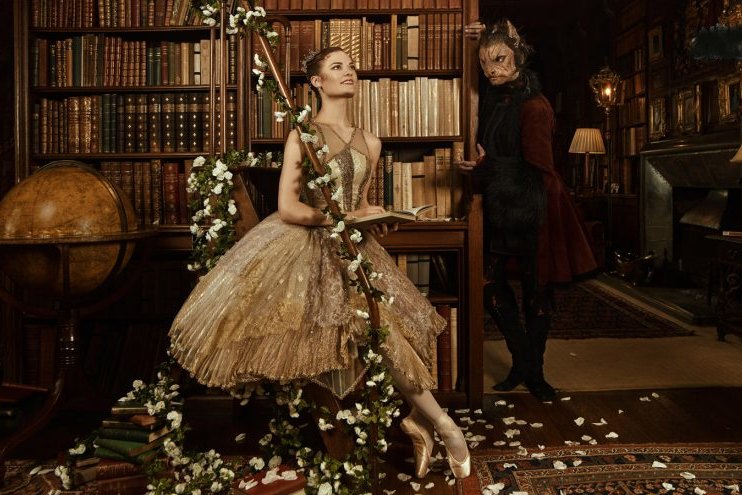
Birmingham Royal Ballet’s Beauty And The Beast, choreographed by David Bintley, is a sumptuous treat. Offering spectacle, excitement and more than a little magic, it has a broad appeal that knocks on the head all those old prejudices about ballet being ‘elitist’. From the moment the curtain rises it is clear that this production is no modernist piece of abstract minimalism, for Philip Prowse’s set designs are grandly proportioned, exquisitely detailed and darkly atmospheric. The dominant colour is a rich bronze. The story is the familiar one of a dutiful daughter, Belle, who in order to save her much-loved father’s life agrees to stay in the Beast’s castle. The Beast is a handsome prince who has been punished for his cruelty by being transformed into a monster, and all his servants have been turned into animals.
Well-known it might be, but a great strength of this version is the subtlety and depth with which this tale is conveyed. For example, when Belle first encounters the Beast, she is sat alone, and he approaches her from behind. This could be a moment of terror, but his entry is accompanied by a wistful cello solo, and there is a hesitancy in his movements. Yes, he is predatory, and she is his victim, but there is also tenderness and pity in their relationship. Their cautious pas de deux explores these emotional complexities further; he rages against his grotesque transformation, and she is fearful, yet moved by his suffering. In last night’s performance Delia Matthews was a wonderfully graceful Belle, conveying her vulnerability and inner strength of character with a seemingly effortless fluidity. She was well matched by Tyrone Singleton’s Beast, a hard-hearted prince who becomes a self-loathing creature, desperate for love. When he reluctantly lets Belle return to her father he very nearly dies of a broken heart. There is a Wagnerian scene where he is draped in black and laid out as if on his funeral bier. Glenn Buhr’s score is effective throughout, but here it is especially impressive, all muffled drum beats and mournful horns. Belle, of course, returns just in time to save him. In their second pas de deux the hesitancy and fear have gone, and they dance in joyful union.
The dark romance at the centre of this story is juxtaposed with some very light-hearted comedy. Belle is lumbered with two horrible sisters, Fière and Vanité. It’s a mystery why her kindly father should tolerate this spoilt, mean-spirited duo, but that’s fairytale for you. Laura Purkiss and Samara Downs are wonderfully pouty and petulant in these roles, with every gesture conveying their shallow self-importance. They are wooed by Monsieur Cochon, a wealthy pig-nosed, popinjay who cannot choose which daughter to marry. James Barton has great fun as Cochon, who confidently struts his stuff while being totally unaware of his own puffed-up silliness.
Among other solo performances, that of Tzu-Chao Chou’s vigorously expressive turn as the Raven deserves a mention, as does Yaoquian Shang’s depiction of the Wild Girl, a vixen in human form. As might be expected from this company, the ensemble performances are excellent throughout. Act II begins with a magnificent ball danced by all the Beast’s animal-servants, but perhaps the most spectacular and brilliantly choreographed sequence is that when Belle travels to the Beast’s castle borne aloft by a flock of ravens. Mark Jonathan’s clever lighting design adds much to the mystery and magic, and three cheers for a production with a real live orchestra, the splendid Royal Ballet Sinfonia, under the expert direction of Philip Ellis.
I thoroughly enjoyed Beauty And The Beast. If I have one minor criticism it is that in Act I the machinations involving unpaid debts, bailiffs and ships that may or may not be lost at sea seem an unnecessarily complicated way to get Belle’s father out into a storm. However, once he takes shelter in the Beast’s castle the narrative becomes much more energised.
Beauty And The Beast is unashamedly a traditional, fairytale ballet, but one with real depth and originality. It is not as revolutionary or iconoclastic as Mathew Bourne’s Swan Lake, but it is packed with imaginative ideas and it is performed with exceptional artistry by all concerned. Magnificent. ★★★★★ Mike Whitton 2nd May 2019

